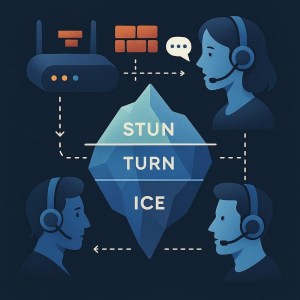NAT Traversal & TUN/TURN/ICE Why VoIP Falls Behind Home Routers (And How to Fix It)

If your VoIP calls sound muffled, keep dropping, or end in the dreaded “Can you hear me?” loop, the culprit is often your router. Specifically, the issue lies with NAT (Network Address Translation). NAT hides your device’s real IP address, which makes it difficult for VoIP traffic to find the right path.
The fix? Proven technologies such as STUN, TURN, and ICE are smart tools that ensure your calls connect reliably, no matter how complex the network setup.
The Secret Issue That Few Companies Are Aware of.
You have invested in a VoIP system, and you are hoping to get a clear and reliable call. But instead, you face:
- Calls dropping mid-sentence.
- One-way communication (you can hear them, and vice versa, they cannot hear you)
- Frustrating “Hello? … Are you still there?” exchanges
To a business, this is not merely an inconvenience; it is not professional. Each missed word or missed call eats away at your credibility and undermines the productivity of your team.
Why NAT Trips Up VoIP
Think of your office network as a busy pub. Nat is the bouncer at the door. Instead of using names, the bouncer assigns table numbers. To the outside world, everyone looks like “Table 7,” not Janet, Martin, or Steve.
That is okay in browsing websites or emails. But VoIP demands the knowledge of your precise location as you are sitting to transmit two-way audio. When NAT conceals your real seat number, voice information may be diverted out of place—resulting in dropped calls, silence, or a stuttering voice.
The Business Cost of Poor Call Quality
In case you have a problem with your VoIP telephone service:
- Reputation: Clients may see your company as unreliable.
- Productivity: Staff waste time redialing or switching to mobiles.
- Costs: You’re paying for modern telephony that performs like outdated tech.
Put simply, poor VoIP quality drains your brand image, efficiency, and bottom line.
The Solution: STUN, TURN & ICE (No, Not a Boyband).
Thankfully, the industry has solved this problem. The key players are:
- STUN (Session Traversal Utilities for NAT).
Analogy: To request the bouncer to provide other people with your real name.
What it does: Helps devices discover their public IP address so calls know exactly where to connect.
- TURN (Traversal Using Relays around NAT)
Analogy: In case the bouncer is not willing to cooperate, TURN gets a waiter to deliver messages with certainty.
What it does: Relays audio through a server when direct peer-to-peer isn’t possible.
- ICE (Interactive Connectivity Establishment)
Analogy: The matchmaker follows all the routes (direct, STUN, TURN) and selects the best.
What it does: Coordinates STUN and TURN to ensure the most stable connection.

How PineVox Handles It Seamlessly
The good news here is that with PineVox, you do not have to worry about configuring or knowing anything about NAT traversal. We do auto-management of STUN, TURN, and ICE. The result? Clear, consistent calls with no problems.
Why this is important to SMEs in the UK.
Even the most basic home or office router used by most small businesses is based on NAT. Your VoIP phone service is more like playing blindfolded darts without NAT traversal.
Using STUN, TURN, and ICE, you have:
- Reliable audio on every call.
- Reduced dropped conversations.
- A business phone system that will make you look like a professional (not cheap and cheerful gone wrong).
Final Word
VoIP is supposed to strengthen your business and not give you headaches. In the case of PineVox, issues of NAT traversal are managed smoothly in the background. That way, you can get down to what is really important, which is establishing stronger relationships with your clients and your team.
Clear communications, reliable connections, zero hassle
Frequently Asked Questions:
NAT conceals the actual IP address of your device; therefore, your VoIP system cannot always determine where to transmit audio of calls. That results in one-sided sound, missed calls, or no connection altogether.
Resolving the fix typically requires enabling NAT Traversal functionality such as STUN or TURN, adjusting firewall configurations, or a VoIP provider (such as PineVox) that will configure such a solution automatically.
- STUN assists your device to show its real address as a way of letting calls know where to go.
- TURN is a relay server, which direct connections cannot connect to; its routing of audio involves the use of a middleman. They are collectively working to make your calls work.
No, when you have a provider such as PineVox. No technical installation is necessary; we deal with it automatically.